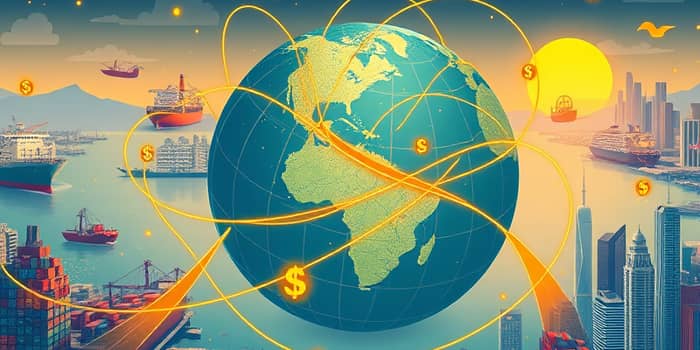
Trade agreements have become powerful levers that shape not only goods exchange but also the movement of global capital. Understanding this dynamic helps policymakers, investors, and businesses navigate an ever more integrated world economy.
The foundational principle is straightforward: a country running a trade surplus generally experiences trade balances directly influence capital flows. When exports exceed imports, the surplus often finances investments abroad, leading to capital outflows. Conversely, a persistent trade deficit draws in foreign funds, resulting in capital inflows that support domestic borrowing and investment.
These shifts manifest through foreign exchange markets. Surpluses tend to strengthen domestic currencies, while deficits can weaken them, adjusting competitiveness and shaping investor sentiment. Over time, currency movements feed back into trade performance, completing a self-regulating cycle.
Contemporary trade deals have evolved far beyond mere tariff cuts. They now routinely encompass services, regulatory harmonization, intellectual property rules, and explicit clauses on capital movement. More than half of the nearly 300 global Preferential Trade Agreements (PTAs) today include commitments on investment and capital markets.
These investment and capital market clauses facilitate smoother cross-border flows by granting foreign investors protections and reducing bureaucratic hurdles. The European Union and the United States have championed such “deep” agreements, pushing for tighter market integration and predictable rules that assure investors of a level playing field.
The long-term statistics are staggering. Since the GATT’s inception in 1948, world imports have surged nearly 260-fold. Agreements like NAFTA and CAFTA-DR link the U.S. and its partners in roughly 30% of global trade, reflecting the potency of regional integration.
Statistical analyses reveal a strong correlation between the combined FDI stocks of treaty partners and the stringency of capital-related provisions (R² = 0.191, p < .000). In essence, larger investors demand more robust protections and liberalized rules.
When nations sign FTAs, they often relinquish incentives to deploy capital controls, as stable, open regimes reduce the risk of disruptive financial swings. Research confirms that deep agreements can curb capital-control wars and policy responses, replacing defensive barriers with cooperative safeguards.
Economic models indicate that the pairing of free trade and unfettered capital flows yields the maximum welfare with free trade and capital compared to scenarios where countries employ tariffs or controls unilaterally. Yet, in times of severe shocks or low substitutability of traded goods, governments may still resort to blended strategies.
Canada exemplifies proactive engagement, with 31 FIPAs and negotiations underway with over 24 partners. Such agreements have attracted foreign capital while securing access for Canadian investors abroad. The EU’s Customs Union and single market further illustrate how integrated frameworks channel capital to their most productive uses.
In North America, successive agreements have deepened ties. NAFTA’s evolution into the USMCA, for instance, broadened chapters on digital trade and state-owned enterprises. The result is a mosaic of rules that not only shape goods movement but also funnel investment toward dynamic, high-value sectors.
For governments, crafting agreements that balance openness with regulatory autonomy is paramount. Well-designed treaties lock in reforms, enhance transparency, and offer mechanisms for dispute resolution that reassure investors. In turn, businesses gain from strengthening intellectual property protection and streamlined cross-border procedures.
Corporate strategies now routinely incorporate treaty analysis, ensuring that market entry, mergers, and greenfield investments align with the evolving legal landscape. Firms that anticipate regulatory shifts can position themselves to capitalize on emerging opportunities.
The trend toward “deep” integration shows no sign of abating. New agreements increasingly address competition policy, environmental standards, and labor rights, marking a shift from purely commercial concerns to broader sustainable development goals.
One key debate centers on preserving policy space for essential public goods while maintaining investor confidence. Empirical studies underscore the need for clarity, enforceability, and flexibility to adapt to geopolitical and technological changes.
As trade agreements evolve, they reshape the flows of international capital, unlocking growth but also demanding nuanced policymaking. By understanding the intricate ties between trade balances, regulatory frameworks, and financial markets, stakeholders can better navigate global opportunities and challenges.
In an interconnected world, the power to influence cross-border capital movement lies at the heart of economic strategy, reshaping the global financial landscape for decades to come.













